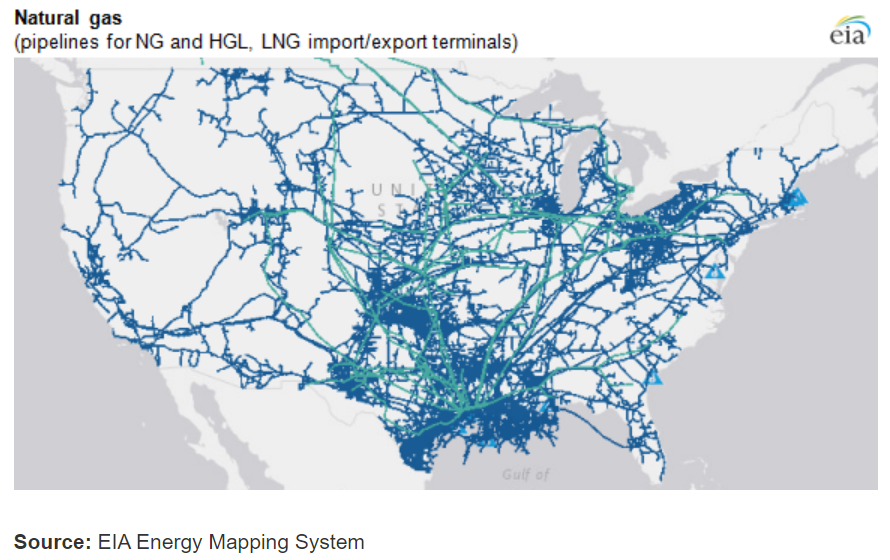Explore Other Resources
Subscribe Today!
Challenges in U.S. Natural Gas Distribution: Impact on Affordability and Reliability for Consumers
Navigating the dynamics of the U.S. energy sector reveals a fascinating paradox—a nation rich in natural gas faces intricate challenges in efficiently transporting this abundant resource. Despite the wealth of this valuable energy source, the journey from production hubs to areas of demand is marked by hurdles. Outdated infrastructure and resistance to pipeline projects weave a complex narrative, where the surplus in one region sharply contrasts with shortages in another. This blog post will delve into the reasons for the regional disparities and how it impacts your energy costs.
The United States is facing some challenges when it comes to getting natural gas where it's needed. In some places, like the Northeast, it can be challenging to get enough gas delivered, especially in the winter due to restricted pipeline capacity. This can make gas more expensive in these areas. On the other hand, in places like West Texas, there's so much natural gas that it can't all be used or sent to other places, leading to waste. These issues mean that the price and availability of natural gas can vary a lot depending on where your business is located.
- The transportation of natural gas from its origin to areas of demand involves navigating various challenges. In certain regions, shortages arise due to inadequate infrastructure, while others grapple with an excess, resulting in flare gas.
- The imbalance between supply and demand often results in prices fluctuating in relation to the national benchmark, NYMEX. In areas where delivery is more challenging, end users pay a premium compared to the benchmark, while in surplus regions, the cost is discounted relative to the benchmark.
- The infrastructure required for a more effective and efficient transportation of natural gas from source to destination is often hindered by regulatory and environmental concerns.

In recent years, the United States has experienced a remarkable shift in its natural gas industry, primarily due to innovative technologies like hydraulic fracturing (fracking) and advanced horizontal drilling methods. These techniques, which gained significant traction since the mid-2000s, have unlocked substantial natural gas reserves previously trapped in shale formations. This breakthrough has repositioned the U.S. from being a natural gas importer to a prominent exporter, altering the nation's energy dynamics drastically.
At the heart of natural gas distribution is a vast and complex pipeline network that spans the country, originating from shale extraction sites. The gas undergoes initial processing to eliminate impurities before it enters this network, which includes an array of pipelines, from smaller local lines to major interstate conduits, supplemented by strategically situated compressor stations to maintain efficient flow. In areas where pipelines aren't feasible, liquefied natural gas (LNG) terminals and transport trucks play an important role, ensuring that natural gas is accessible across the nation.
Despite its plentiful production, the pricing of natural gas in the U.S. shows notable regional variances. These discrepancies arise from a mix of factors including supply and demand dynamics, infrastructure differences, and environmental regulations. Regions with limited production or pipeline access, fluctuating local demands due to weather and economic conditions, and infrastructural bottlenecks like aging pipelines and capacity issues often see price volatility. Additionally, regulatory and environmental hurdles in pipeline expansion further contribute to these regional pricing disparities, directly affecting the costs and reliability for end users.
A case in point is the Northeastern U.S., where natural gas prices frequently exceed the national benchmark (NYMEX Henry Hub), creating uncertainties for businesses and impeding economic growth. In contrast, areas with surplus production often sell gas at significantly lower prices compared to this benchmark, sometimes even resorting to flaring excess gas. The ongoing debate over fossil fuels and resistance to pipeline projects add complexity to the energy transition, creating challenges in maintaining consistent reliance on natural gas. Routine delays and increased costs in pipeline development also lead to unpredictable price fluctuations, especially during periods of high demand, affecting the overall energy costs for consumers.
In summary, the efficient transportation and distribution of natural gas to various regions carry substantial implications for end-users, influencing both the reliability and affordability of the supply. Balancing the goals of reducing emissions while ensuring grid reliability, especially during peak demand, presents a significant challenge. This scenario underscores an urgent need for holistic solutions that address the intricacies and shortcomings of the U.S. pipeline infrastructure.
For additional information please contact us to schedule a quick call.
